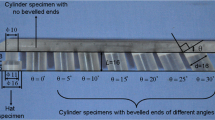Abstract
In this paper studies conducted on Polymethyl methacrylate (PMMA) under combined bending and shear loading are described. A strong dependency of fracture surface features on the mixed mode stress state is observed. Close to pure mode I, the fracture surface is ‘mirror-like’ in appearance. With increasing mode II component the fracture surface becomes ‘misty’ and parabolic markings appear on the fracture surface. These observations indicate that the level of stress ahead of the crack tip increases with increasing mode II component. The mixed mode specimens are also observed to fracture at much higher stresses than the pure mode I specimen, contrary to the predictions of the fracture criteria based on linear elastic fracture mechanics (LEFM). The fracture surface features and the higher stresses at fracture in the mixed mode specimens are explained in terms of the increase in stiffness (which has been related to an increase in the effective stress intensity factor per unit opening displacement) with the introduction of a mode II component and the geometry of the 3-dimensional crack tip.
Similar content being viewed by others
References
M. Higuchi, Reports of Research, Institute for Applied Mechanics, Kyushu University 6 (1958) 173–179.
J.P. Berry, Journal of Polymer Science 50 (1961) 107–115.
R.P. Kambour, Journal of Polymer Science, Macromolecular Reviews 7 (1973) 1–154.
P. Beardmore and J. Fellers, Materials Science and Engineering 5 (1969/70) 120–125.
P.D. Washabaugh and W.G. Knauss, International Journal of Fracture 59 (1993) 189–197.
W. Döll, in Fractography and Failure Mechanisms of Polymers and Composites, A.C. Roulin-Moloney (ed.), Elsevier (1989) 387–429.
F. Erdogan and G.C. Sih, Transactions of ASME, Journal of Basic Engineering 85 (1963) 519–527.
G.C. Sih, Engineering Fracture Mechanics 5 (1973) 365–377.
M.A. Hussain, S.L. Pu and J. Underwood, ASTM STP 560 (1974) 2–28.
T.M. Maccagno and J.F. Knott, Engineering Fracture Mechanics 34 (1989) 65–86.
D. Bhattacharjee and J.F. Knott in Mixed-Mode Fatigue and Fracture, ESIS14, K.J. Miller and H.P. Rossmanith (eds) MEP, London (1993) 99–109.
S. Suresh, C.F. Shih, A. Morrone and N.P. O'Dowd, Journal of the American Ceramic Society 73 (1990) 1257–1267.
G.P. Marshall and J.G. Williams, Journal of Materials Science 8 (1973) 138.
R.D. Margolis, R.W. Dunlap and H. Markowitz, ASTM STP 601 (1976) 391–408.
B.W. Guest and B.L. Karihaloo, Journal of Materials Science Letters 4 (1985) 1285–1289.
T.M. Maccagno and J.F. Knott, Engineering Fracture Mechanics 38 (1991) 111–128.
C.F. Shih, ASTM STP 560 (1974) 187–210.
J.W. Hutchinson, Journal of Mechanics and Physics of Solids 16 (1968) 13–31.
J.R. Rice and G.F. Rosengren, Journal of Mechanics and Physics of Solids 16 (1968) 1–12.
J.C.W. Davenport and D.J. Smith, Fatigue and Fracture of Engineering Materials and Structures 16 (1993) 1125–1133.
J.G. Williams and G.P. Marshall, Proceedings of the Royal Society 342 A (1975) 55–77.
B. Lawn, Fracture of Brittle Solids, 2nd edn., Cambridge University Press, Cambridge (1993).
D. Hull, International Journal of Fracture 62 (1993) 119–138.
A. Carpenteri, S. Valente, G. Ferrara and G. Melchiorri, in Mixed-Mode Fatigue and Fracture, ESIS 14, H.P. Rossmanith and K.J. Miller (eds), MEP, London (1993) 171–183.
M. Bevis and D. Hull, Journal of Materials Science 5 (1970) 983–987.
Y. Ueda, K. Ikeda, T. Yao and M. Aoki, Engineering Fracture Mechanics 18 (1983) 1131–1158.
S.K. Maiti and R.A. Smith, Journal of Mechanics and Physics of Solids 31 (1983) 389–403.
R.V. Mahajan and K. Ravi-Chandar, International Journal of Fracture 41 (1989) 235–252.
H.-A. Richard, Bruchvorhersagen bei überlagerter Normal-und Schubbeanspruchung von Rissen, in VDI-Forshcungshaft 631, VDI Verlag, Dusseldorf (1985).
Author information
Authors and Affiliations
Rights and permissions
About this article
Cite this article
Bhattacharjee, D., Knott, J.F. Effect of mixed mode I and II loading on the fracture surface of polymethyl methacrylate (PMMA). Int J Fract 72, 359–381 (1995). https://doi.org/10.1007/BF00040373
Received:
Accepted:
Issue Date:
DOI: https://doi.org/10.1007/BF00040373




